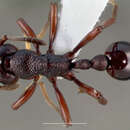en
names in breadcrumbs


[[ worker ]]. Clipeo breve, col margine anteriore prolungato a punta nel mezzo, col margine posteriore rialzato in forma di cercine ottuso, innanzi alla fossa antennale. Mandibole trigone, con margine dentato. Lamine frontali piu corte dello scapo. Antenne grosse, di 12 articoli, articoli 3 - 9 brevi, trasversi, i 3 ultimi piu lunghi, ma appena piu grossi, formano una clava poco distinta. Pronoto non marginato, fuso col mesonoto, zampe con speroni semplici.
Nella [[ queen ]], il torace non e molto robusto e il pronoto e scoperto. Del resto simile alla [[ worker ]]. Ali ignote.
La struttura del capo ricorda il genere Tetramorium , pero mi parve piu conveniente istituire un genere nuovo, anziche considerare questo gruppo come sottogenere di Tetramorium . E particolarmente caratteristica la struttura delle antenne che ricorda il genere Podomyrma ; anche l'aspetto generale richiama alla mente questo genere.
Eutetramorium is a small genus of ants within the subfamily Myrmicinae. To date it contains three species found in Madagascar and Comoros.[3]
The queen is extremely ergatoid in E. mocquerysi, alate in E. monticellii. In E. parvum a normal dealate queen is present in the type-series, but there is also a specimen that may be an ergatoid or a worker-queen intercaste, or possibly merely an oversized worker. Males are known only for E. mocquerysi, where it is smaller than conspecific workers.[3]
This small genus was established by Emery (1899) for two conspicuous, large, darkly coloured Madagascan species that superficially resemble Tetramorium. Initially, Emery (1912, 1914) was of the opinion that the genus was referable to the tribe Myrmecinini, but Ashmead (1905) and Wheeler (1910) had already referred it to Tetramoriini, an opinion that Emery (1915, 1924) also came to accept. Bolton (1976) excluded Eutetramorium from Tetramoriini on morphological grounds, and tentatively transferred it to Myrmicini. This placement persisted until recently, when a molecular analysis of Myrmicini by Jansen & Savolainen (2010) showed that the monophyly of the tribe was dubious, and that Eutetramorium formed a clade with Huberia. The yet unpublished, more detailed, DNA analysis of Myrmicinae by Philip S. Ward has established that Eutetramorium belongs in a strongly supported, endemic Madagascan clade that also includes the other four genera: Malagidris, Myrmisaraka, Royidris and Vitsika.[3]
Eutetramorium is a small genus of ants within the subfamily Myrmicinae. To date it contains three species found in Madagascar and Comoros.